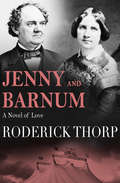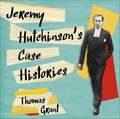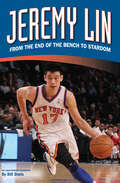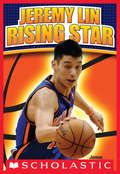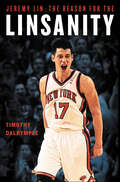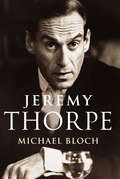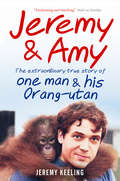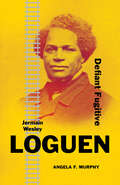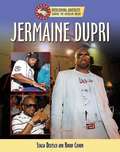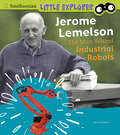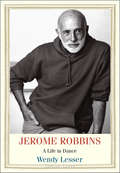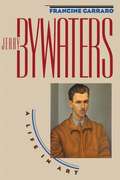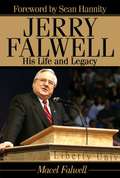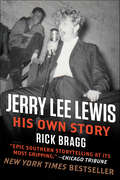- Table View
- List View
Jenny and Barnum: A Novel of Love
by Roderick ThorpA diva and a showman work together to make history, finding romance along the way After Queen Victoria, Jenny Lind is the most famous woman in Europe. A Swedish soprano with a voice like an angel&’s and a temperament to match, she is in Vienna when she meets the shortest man she has ever seen. General Tom Thumb is a three-foot-tall sensation whom P. T. Barnum has made one of the wealthiest men in the world. Thumb arrives with a message from Barnum offering Lind more money than she has ever dreamed of, to do something she has never done before: perform in America. While Lind makes her way across the Atlantic, Barnum, the Great American Showman, whips US audiences into a frenzy. By the time the singer lands in New York, &“Lindomania&” is in full effect. As Lind and Barnum travel the country, they play for packed houses every night. The public loves Lind, but as the tour wears on, P. T. Barnum will come to love her more.
Jeoffry: The Poet's Cat
by Oliver Soden'An inspired an original tale ... Jeoffry is the greatest cat in the English language' - Hilary Mantel'Simply unforgettable ... one of the most beautiful and haunting books of recent times' - Alexander McCall Smith'A heart-lifting delight; I absolutely loved it. A triumph' - Alexandra HarrisJeoffry was a real cat who lived 250 years ago, confined to an asylum with Christopher Smart, one of the most visionary poets of the age. In exchange for love and companionship, Smart rewarded Jeoffry with the greatest tribute to a feline ever written.Prize-winning biographer Oliver Soden combines meticulous research with passages of dazzling invention to recount the life of the cat praised as ‘a mixture of gravity and waggery’. The narrative roams from the theatres and bordellos of Covent Garden to the cell where Smart was imprisoned for mania. At once whimsical and profound, witty and deeply moving, Soden’s biography plays with the genre like a cat with a toy. It tells the story of a poet and a poem, while setting Jeoffry’s life and adventures against the roaring backdrop of eighteenth-century London.
Jeopardy: The Danger of Playing It Safe on the Path to Success
by Wilfred Emmanuel-Jones'Wilfred's sheer ambition is an inspiration. We can all learn from it.' - Peter Bazalgette'Based on my career, Wilfred Emmanuel-Jones' approach to risk can produce huge dividends' - Nigel Travis, chairman of Dunkin' Brands and author of The Challenge CultureJeopardy is the single greatest catalyst for making things happen in life.In Jeopardy, award-winning entrepreneur Wilfred Emmanuel-Jones argues that our natural instinct for caution is one of the greatest barriers to making progress in life, and shows how embracing jeopardy is essential if you want to succeed.Drawing on a life that has taken him from a deprived childhood in inner-city Birmingham to becoming one of the nation's most famous farmers, he demonstrates how we can all go further in life by learning to escape the fears that stop us from achieving our ambitions.Wilfred Emmanuel-Jones is no stranger to jeopardy: he remortgaged his house in 2005 to launch his brand 'The Black Farmer' from nothing. Its products are now stocked in all major supermarkets and the business has an annual turnover of several million. In this book, he shows that only by embracing jeopardy, and liberating ourselves from the shackles of uncertainty and self-doubt, can we realise our full potential.What could you achieve, if you decided to stop letting fear hold you back?
Jeopardy: The Danger of Playing It Safe on the Path to Success
by Wilfred Emmanuel-Jones'Wilfred's sheer ambition is an inspiration. We can all learn from it.' - Peter Bazalgette'Based on my career, Wilfred Emmanuel-Jones' approach to risk can produce huge dividends' - Nigel Travis, chairman of Dunkin' Brands and author of The Challenge CultureJeopardy is the single greatest catalyst for making things happen in life.In Jeopardy, award-winning entrepreneur Wilfred Emmanuel-Jones argues that our natural instinct for caution is one of the greatest barriers to making progress in life, and shows how embracing jeopardy is essential if you want to succeed.Drawing on a life that has taken him from a deprived childhood in inner-city Birmingham to becoming one of the nation's most famous farmers, he demonstrates how we can all go further in life by learning to escape the fears that stop us from achieving our ambitions.Wilfred Emmanuel-Jones is no stranger to jeopardy: he remortgaged his house in 2005 to launch his brand 'The Black Farmer' from nothing. Its products are now stocked in all major supermarkets and the business has an annual turnover of several million. In this book, he shows that only by embracing jeopardy, and liberating ourselves from the shackles of uncertainty and self-doubt, can we realise our full potential.What could you achieve, if you decided to stop letting fear hold you back?
Jeremy Hardy Speaks Volumes: words, wit, wisdom, one-liners and rants
by Jeremy HardyThe best of the best from the Comedians' Comedian 2020'If you loved Jeremy Hardy, or if you know anyone who did, this is the most brilliant present because it's got every part of his voice in it' DAWN FRENCH'Well good evening, my name is Jeremy Hardy and I'm a comedian who likes to make wry witty satirical observations about the society we live in -- but I prefer to keep them to myself, thank you very much.'Edited by his wife, Katie Barlow and his long-time producer David Tyler, this comprehensive celebration of Jeremy Hardy's work is introduced by Jack Dee and Mark Steel. Further reflections on Jeremy come from Rory Bremner, Paul Bassett Davies, Jon Naismith, Francesca Martinez, Sandi Toksvig, Victoria Coren Mitchell, Andy Hamilton, Graeme Garden and Hugo Rifkind. Katie Barlow also provides a moving Afterword.Jeremy Hardy, who died in February 2019, was perhaps the most distinctive and brilliant comedian to arise from the 80s Alternative Comedy circuit. He regularly entertained the millions who heard his outrageous rants on The News Quiz, his legendary singing on I'm Sorry I Haven't a Clue, or his hilarious monologues and sketches on the award-winning Jeremy Hardy Speaks to The Nation and Jeremy Hardy Feels It.Often referred to as 'the comedian's comedian', Jeremy's comedy could be both personal and political, ranging in topics from prison reform to parenting, from British identity to sex. His comedy could be biting, provocative and illuminating, but it could also be surreal, mischievous and, at times, very silly. And while Jeremy's unwavering socialism was a thread that ran throughout his comedy, his greatest skill was that, whatever their political beliefs, Jeremy always brought his audience along with him.Jeremy Hardy Speaks Volumes is a fitting celebration of this brilliant comedian. Introduced by Jack Dee and Mark Steel and containing material from his stand-up to his radio monologues and political satire to the joyfully silly gems, as well as tributes from his friends and fellow comedians, it is curated to encompass everything about Jeremy that fans adored. Edited by Katie Barlow and David Tyler, Jeremy Hardy Speaks Volumes is wise, daft, outrageous, personal and, above all, very funny: like Jeremy himself.'Ground-breakingly brilliant, off-the-register funny' JACK DEE'A one-off. Part genius, part naughty schoolboy' SANDI TOKSVIG'Unfussy, unshowy, principled, self-deprecating, hugely loved and admired by his fellow comedians and funnier than the lot of us put together' RORY BREMNER
Jeremy Hardy Speaks Volumes: words, wit, wisdom, one-liners and rants
by Jeremy HardyThe best of the best from the Comedians' Comedian 2020'If you loved Jeremy Hardy, or if you know anyone who did, this is the most brilliant present because it's got every part of his voice in it' DAWN FRENCH'Well good evening, my name is Jeremy Hardy and I'm a comedian who likes to make wry witty satirical observations about the society we live in -- but I prefer to keep them to myself, thank you very much.'Edited by his wife, Katie Barlow and his long-time producer David Tyler, this comprehensive celebration of Jeremy Hardy's work is introduced by Jack Dee and Mark Steel. Further reflections on Jeremy come from Rory Bremner, Paul Bassett Davies, Jon Naismith, Francesca Martinez, Sandi Toksvig, Victoria Coren Mitchell, Andy Hamilton, Graeme Garden and Hugo Rifkind. Katie Barlow also provides a moving Afterword.Jeremy Hardy, who died in February 2019, was perhaps the most distinctive and brilliant comedian to arise from the 80s Alternative Comedy circuit. He regularly entertained the millions who heard his outrageous rants on The News Quiz, his legendary singing on I'm Sorry I Haven't a Clue, or his hilarious monologues and sketches on the award-winning Jeremy Hardy Speaks to The NationandJeremy Hardy Feels It.Often referred to as 'the comedian's comedian', Jeremy's comedy could be both personal and political, ranging in topics from prison reform to parenting, from British identity to sex. His comedy could be biting, provocative and illuminating, but it could also be surreal, mischievous and, at times, very silly. And while Jeremy's unwavering socialism was a thread that ran throughout his comedy, his greatest skill was that, whatever their political beliefs, Jeremy always brought his audience along with him.Jeremy Hardy Speaks Volumes is a fitting celebration of this brilliant comedian. Introduced by Jack Dee and Mark Steel and containing material from his stand-up to his radio monologues and political satire to the joyfully silly gems, as well as tributes from his friends and fellow comedians, it is curated to encompass everything about Jeremy that fans adored. Edited by Katie Barlow and David Tyler, Jeremy Hardy Speaks Volumes is wise, daft, outrageous, personal and, above all, very funny: like Jeremy himself.'Ground-breakingly brilliant, off-the-register funny' JACK DEE'A one-off. Part genius, part naughty schoolboy' SANDI TOKSVIG'Unfussy, unshowy, principled, self-deprecating, hugely loved and admired by his fellow comedians and funnier than the lot of us put together' RORY BREMNER
Jeremy Hutchinson's Case Histories: From Lady Chatterley's Lover to Howard Marks
by Thomas GrantTHE SUNDAY TIMES BESTSELLERSHORTLISTED FOR THE CWA NON-FICTION DAGGER'Thomas Grant has brought together Hutchinson's greatest legal hits, producing a fascinating episodic cultural history of post-war Britain that chronicles the end of deference and secrecy, and the advent of a more permissive society . . . Grant brings out the essence of each case, and Hutchinson's role, with clarity and wit' Ben Macintyre, The Times'An excellent book . . . Grant recounts these trials in limpid prose which clarifies obscurities. A delicious flavouring of cool irony, which is so much more effective than hot indignation, covers his treatment of the small mindedness and cheapness behind some prosecutions' Richard Davenport-Hines, GuardianBorn in 1915 into the fringes of the Bloomsbury Group, Jeremy Hutchinson went on to become the greatest criminal barrister of the 1960s, '70s and '80s. The cases of that period changed society for ever and Hutchinson's role in them was second to none. In Case Histories, Jeremy Hutchinson's most remarkable trials are examined, each one providing a fascinating look into Britain's post-war social, political and cultural history.Accessibly and entertainingly written, Case Histories provides a definitive account of Jeremy Hutchinson's life and work. From the sex and spying scandals which contributed to Harold Macmillan's resignation in 1963 and the subsequent fall of the Conservative government, to the fight against literary censorship through his defence of Lady Chatterley's Lover and Fanny Hill, Hutchinson was involved in many of the great trials of the period. He defended George Blake, Christine Keeler, Great Train robber Charlie Wilson, Kempton Bunton (the only man successfully to 'steal' a picture from the National Gallery), art 'faker' Tom Keating, and Howard Marks who, in a sensational defence, was acquitted of charges relating to the largest importation of cannabis in British history. He also prevented the suppression of Bernardo Bertolucci's notorious film Last Tango in Paris and did battle with Mary Whitehouse when she prosecuted the director of the play Romans in Britain.Above all else, Jeremy Hutchinson's career, both at the bar and later as a member of the House of Lords, has been one devoted to the preservation of individual liberty and to resisting the incursions of an overbearing state. Case Histories provides entertaining, vivid and revealing insights into what was really going on in those celebrated courtroom dramas that defined an age, as well as painting a picture of a remarkable life.To listen to Jeremy Hutchinson being interviewed by Helena Kennedy on BBC Radio 4's A Law Unto Themselves, please follow the link: http://www.bbc.co.uk/programmes/b04d4cpvYou can also listen to him on BBC Radio 4's Desert Island Discs with Kirsty Young: http://www.bbc.co.uk/programmes/b03ddz8m
Jeremy Hutchinson's Case Histories: From Lady Chatterley's Lover to Howard Marks
by Thomas GrantTHE SUNDAY TIMES BESTSELLERSHORTLISTED FOR THE CWA NON-FICTION DAGGER'Thomas Grant has brought together Hutchinson's greatest legal hits, producing a fascinating episodic cultural history of post-war Britain that chronicles the end of deference and secrecy, and the advent of a more permissive society . . . Grant brings out the essence of each case, and Hutchinson's role, with clarity and wit' Ben Macintyre, The Times'An excellent book . . . Grant recounts these trials in limpid prose which clarifies obscurities. A delicious flavouring of cool irony, which is so much more effective than hot indignation, covers his treatment of the small mindedness and cheapness behind some prosecutions' Richard Davenport-Hines, GuardianBorn in 1915 into the fringes of the Bloomsbury Group, Jeremy Hutchinson went on to become the greatest criminal barrister of the 1960s, '70s and '80s. The cases of that period changed society for ever and Hutchinson's role in them was second to none. In Case Histories, Jeremy Hutchinson's most remarkable trials are examined, each one providing a fascinating look into Britain's post-war social, political and cultural history.Accessibly and entertainingly written, Case Histories provides a definitive account of Jeremy Hutchinson's life and work. From the sex and spying scandals which contributed to Harold Macmillan's resignation in 1963 and the subsequent fall of the Conservative government, to the fight against literary censorship through his defence of Lady Chatterley's Lover and Fanny Hill, Hutchinson was involved in many of the great trials of the period. He defended George Blake, Christine Keeler, Great Train robber Charlie Wilson, Kempton Bunton (the only man successfully to 'steal' a picture from the National Gallery), art 'faker' Tom Keating, and Howard Marks who, in a sensational defence, was acquitted of charges relating to the largest importation of cannabis in British history. He also prevented the suppression of Bernardo Bertolucci's notorious film Last Tango in Paris and did battle with Mary Whitehouse when she prosecuted the director of the play Romans in Britain.Above all else, Jeremy Hutchinson's career, both at the bar and later as a member of the House of Lords, has been one devoted to the preservation of individual liberty and to resisting the incursions of an overbearing state. Case Histories provides entertaining, vivid and revealing insights into what was really going on in those celebrated courtroom dramas that defined an age, as well as painting a picture of a remarkable life.To listen to Jeremy Hutchinson being interviewed by Helena Kennedy on BBC Radio 4's A Law Unto Themselves, please follow the link: http://www.bbc.co.uk/programmes/b04d4cpvYou can also listen to him on BBC Radio 4's Desert Island Discs with Kirsty Young: http://www.bbc.co.uk/programmes/b03ddz8m
Jeremy Hutchinson's Case Histories: From Lady Chatterley's Lover to Howard Marks
by Thomas Grant'Throughout a long career, [Jeremy Hutchinson's] brilliant and stylish advocacy achieved success in cases that looked unwinnable' Helena Kennedy'Jeremy was not just a good lawyer; he was fearless in standing up to judges. He was the most formidable advocate of the 1960s and '70s and he had a marvellous sense of mischief' Geoffrey RobertsonBorn in 1915 into the fringes of the Bloomsbury Group, Jeremy Hutchinson went on to become the greatest criminal barrister of the 1960s, '70s and '80s. The cases of that period changed society for ever and Hutchinson's role in them was second to none. In Case Histories, Thomas Grant examines Jeremy Hutchinson's most remarkable trials, each one providing a fascinating look into Britain's post-war social, political and cultural history.Accessibly and entertainingly written, Case Histories provides a definitive account of Jeremy Hutchinson's life and work. From the sex and spying scandals which contributed to Harold Macmillan's resignation in 1963 and the subsequent fall of the Conservative government, to the fight against literary censorship through his defence of Lady Chatterley's Lover and Fanny Hill, Hutchinson was involved in many of the great trials of the period. He defended George Blake, Christine Keeler, Great Train robber Charlie Wilson, Kempton Bunton (the only man successfully to 'steal' a picture from the National Gallery), art 'faker' Tom Keating, and Howard Marks who, in a sensational defence, was acquitted of charges relating to the largest importation of cannabis in British history. He also prevented the suppression of Bernardo Bertolucci's notorious film Last Tango in Paris and did battle with Mary Whitehouse when she prosecuted the director of the play Romans in Britain.Above all else, Jeremy Hutchinson's career, both at the bar and later as a member of the House of Lords, has been one devoted to the preservation of individual liberty and to resisting the incursions of an overbearing state. Case Histories provides entertaining, vivid and revealing insights into what was really going on in those celebrated courtroom dramas that defined an age, as well as painting a picture of a remarkable life.To listen to Jeremy Hutchinson being interviewed by Helena Kennedy on BBC Radio 4's A Law Unto Themselves, please follow the link: http://www.bbc.co.uk/programmes/b04d4cpvYou can also listen to him on BBC Radio 4's Desert Island Discs with Kirsty Young: http://www.bbc.co.uk/programmes/b03ddz8m(P)2015 John Murray Press
Jeremy Lin: From the End of the Bench to Stardom
by Bill DavisThis true story is truly &“Lin-sane!&” The world is exposed to an individual like Jeremy Lin only once in a generation. His journey has taken him from practicing lay-ups on the court at the local YMCA to hitting last minute game-winners on the grand stage at Madison Square Garden. This book charts Jeremy&’s life story, from the streets of Palo Alto to the dormitories of Harvard to the major arenas throughout the country. Through exclusive interviews, play-by-plays, and colorful recollections, we get an intimate look at Jeremy&’s story. It is one of unyielding determination, true faith, and unimaginable success.
Jeremy Lin: Rising Star
by James Buckley Jr.The biography of worldwide basketball sensation, Jeremy Lin!Jeremy Lin is an overnight basketball success! But in order for him to have been ready for his big opportunity, he had to put in years of hard work and practice. Follow along as we trace Jeremy's rise from his high-school days, college hoops at Harvard, and bouncing around the NBA to his awesome, unprecedented performances with the New York Knicks. It's Lin-credible!
Jeremy Lin: The Reason for the Linsanity
by Timothy DalrympleHarvard graduate Jeremy Lin recently became a New York Knicks phenomenon and he's the NBA's first American-born player of Taiwanese descent. The book will chronicle Lin's high school, college and early career in the NBA with particular emphasis on the media explosion surrounding his success as starting point guard with the Knicks. It will explore how Jeremy's Christian faith, family, education and cultural inheritance have contributed to his success. The book will also include interviews with basketball experts on Jeremy's future in the NBA, Asian-American thought leaders on the role of race in Jeremy's rise to stardom, and renowned Christian athletes and pastors on the potent combination of faith and sports.
Jeremy Thorpe
by Michael Bloch'A revealing, insightful and gripping biography of one of the most extraordinary people ever to lead a British political party' ObserverThe story of Jeremy Thorpe's rapid rise and spectacular fall from grace is one of the most remarkable in British politics. When he became leader of the Liberal Party in 1967 at the age of just thirty-seven, he seemed destined for truly great things. But as his star steadily rose so his nemesis drew ever nearer: a time-bomb in the form of Norman Scott, a homosexual wastrel and sometime male model with whom Jeremy had formed an ill-advised relationship in the early 1960s. Scott's incessant boasts about their 'affair' became increasingly embarrassing, and eventually led to a bizarre murder plot to shut him up for good. Jeremy was acquitted of involvement but his career was in ruins.Michael Bloch's magisterial biography is not just a brilliant retelling of this amazing story; ten years in the making, it is also the definitive character study of one of the most fascinating figures in post-war British politics.
Jeremy Thorpe
by Michael Bloch'A revealing, insightful and gripping biography of one of the most extraordinary people ever to lead a British political party' ObserverThe story of Jeremy Thorpe's rapid rise and spectacular fall from grace is one of the most remarkable in British politics. When he became leader of the Liberal Party in 1967 at the age of just thirty-seven, he seemed destined for truly great things. But as his star steadily rose so his nemesis drew ever nearer: a time-bomb in the form of Norman Scott, a homosexual wastrel and sometime male model with whom Jeremy had formed an ill-advised relationship in the early 1960s. Scott's incessant boasts about their 'affair' became increasingly embarrassing, and eventually led to a bizarre murder plot to shut him up for good. Jeremy was acquitted of involvement but his career was in ruins.Michael Bloch's magisterial biography is not just a brilliant retelling of this amazing story; ten years in the making, it is also the definitive character study of one of the most fascinating figures in post-war British politics.
Jeremy and Amy: The Extraordinary True Story of One Man and His Orang-Utan
by Jeremy KeelingThis is a high-wire adventure story of grit and determination, and of love, hope and 88 Capuchin monkeys in the back of a Hercules transport plane, but most of all, at its heart, it is an inspiring tale of the life-changing bond between one man and his ape.
Jeremy and Amy: The Extraordinary True Story of One Man and His Orang-Utan
by Jeremy KeelingThis is a high-wire adventure story of grit and determination, and of love, hope and 88 Capuchin monkeys in the back of a Hercules transport plane, but most of all, at its heart, it is an inspiring tale of the life-changing bond between one man and his ape.
Jermain Wesley Loguen: Defiant Fugitive (Black Lives)
by Angela F MurphyA gripping biography of a man who escaped slavery to become an influential abolitionist, famously known as the &“King of the Underground Railroad&” Jermain Wesley Loguen (1813–1872) was a fugitive from slavery, an abolitionist, and a minister, teacher, and political activist. He worked alongside Harriet Tubman and Frederick Douglass, and his home in Syracuse, New York, was among the most publicized Underground Railroad stations in the northern states. Loguen&’s political commitments in the years before the Civil War were carried out at great personal risk, for he had liberated himself from slavery in Tennessee and was in constant danger of being captured and reenslaved under the Fugitive Slave Law. Defiantly, however, he refused to purchase his own freedom, an act that he believed would have legitimized the rights of slaveholders. In addition to aiding fellow fugitives from slavery, Loguen worked tirelessly to promote Black equality and uplift throughout upstate New York and Canada. After Emancipation, he extended his work to aid freedpeople in the South and to advocate for Black equality on a national scale. In this engaging study, Angela F. Murphy follows Loguen from his early years through his transformation into one of the brightest stars in the constellation of abolitionists and reformers in New York.
Jermaine Dupri
by Stacia Deutsch Rhody CohonBiography of Jermaine Dupri, emphasizing the life challenges/issues faced and how they were overcome.
Jerome Lemelson: The Man Behind Industrial Robots (Little Inventor)
by Lucia RaatmaWhy is Jerome Lemelson important? His inventions helped create industrial robots, cassette players, and more! Readers follow his journey from struggling inventor to a multimillionaire with more than 600 patents. This story of determination is filled with engaging text and colorful images, all reviewed by Smithsonian experts.
Jerome Robbins, by Himself: Selections from His Letters, Journals, Drawings, Photographs, and an Unfinished Memoir
by Jerome RobbinsThe titanic choreographer, creator of memorable ballets, master of Broadway musicals, legendary show doctor and director, now revealed in his own words--the closest we will get to a memoir/autobiography--from his voluminous letters, journals, notes, diaries, never before published. Edited, and with commentary by Amanda Vaill, author of Robbins's biography, Somewhere, 2006 ("I can't imagine a better book about Robbins ever being written"--Terry Teachout, chief drama critic, The Wall Street Journal).He was famous for reinventing the Broadway musical, creating a vernacular American ballet, pushing the art form to new boundaries where it had never gone before, integrating dance seamlessly with character, story and music, and as Associate Artistic Director, Ballet Master, and Co-Artistic Director, with George Balanchine, shaping the New York City Ballet with daring and brio for more than five decades through his often startling choreography in ballet's classical idiom. He was known as the king of Broadway, the most sought-after director-choreographer and show doctor who gave shape to On the Town (1944), Call Me Madam (1950), The King and I (1951), Wonderful Town (1953), Peter Pan (1954), The Pajama Game (1954), Silk Stockings (1955), West Side Story (1957), Gypsy (1959), A Funny Thing Happened on the Way to the Forum (1962), Funny Girl (1964), Fiddler on the Roof (1964), and many other classic musicals, winning four Tony Awards, two Oscars, and an Emmy. He shocked and betrayed those he loved and worked with by naming names to the House Un-American Activities Committee. ("I betrayed my manhood, my Jewishness, my parents, my sister," he wrote in a diary. "I can't undo it.") Now, Amanda Vaill, Jerome Robbins biographer and authority, drawing on the vast and closely held Robbins archives, has put together a selection of his writings, giving us a sense of his extraordinary range as a thinker and artist, as well as a surprising and revealing glimpse into the mind and heart of this towering cultural giant. Interspersed throughout, his correspondence with George Balanchine, Leonard Bernstein, Aaron Copland, Robert Graves, Lincoln Kirstein, Arthur Laurents, Tanaquil Le Clercq (the fourth of Balanchine's four wives, with whom Robbins was also in love), Laurence Olivier, Stephen Sondheim, et al.
Jerome Robbins: A Life in Dance (Jewish Lives)
by Wendy LesserA lively and inspired biography celebrating the centennial of this master choreographer, dancer, and stage director Jerome Robbins (1918–1998) was born Jerome Wilson Rabinowitz and grew up in Weehawken, New Jersey, where his Russian-Jewish immigrant parents owned the Comfort Corset Company. Robbins, who was drawn to dance at a young age, resisted the idea of joining the family business. In 1936 he began working with Gluck Sandor, who ran a dance group and convinced him to change his name to Jerome Robbins. He went on to become a choreographer and director who worked in ballet, on Broadway, and in film. His stage productions include West Side Story, Peter Pan, and Fiddler on the Roof. In this deft biography, Wendy Lesser presents Jerome Robbins’s life through his major dances, providing a sympathetic, detailed portrait of her subject.
Jerry Bywaters: A Life in Art
by Francine CarraroWhen twelve-year-old Seema Trivedi learns that she and her family must move from their small Indian town to Iowa City, she realizes she'll have to say good-bye to the purple-jeweled mango trees and sweet-smelling jasmine, to the monsoon rains and the bustling market. More important, she must leave behind her best friend and cousin, Raju. Everything is different in Iowa City, where Seema feels like an outsider to the language and traditions. As she begins to plant roots in the foreign soil, however, her confidence starts to bloom, and she learns she can build a bridge between two homes. With lyrical language and poignant scenes, Kashmira Sheth unearths the meaning of "home" and "family" in this tender debut novel. Kashmira Sheth's own experiences as a teenager who moved by herself from India to America inspired her to write this novel. She is a microbiologist and lives with her family in Madison, Wisconsin. Kashmira Sheth was born in Bhavanger, Gujart, India and immigrated to the United States at the age of 17. Sheth attended Iowa State University where she received her B. S. in Microbiology. She is married to a civil engineer and they have two daughters. Sheth is both a scientist and an author. Sheth has worked for the Wisconsin Department of Agriculture, Trade and Consumer Protection as a microbiologist. In 2012 she will teach at the Solstice Low-Residency MFA in Creative Writing Program at Pine Manor College. In her free time Sheth teaches Indian dance to children. "When 12-year-old Seema moves with her parents and younger sister from India to Iowa City, she must leave her grandparents, extended family, and, most distressingly, her cousin Raju, who has been like a brother to her. Seema describes her adjustment to the newness of the U. S. –the food, clothing, weather, education–and her feelings: "I was always the outsider listening in…. " Although she makes friends, she also encounters surprising hostility from another newcomer to her class, and ultimately learns the coping skills necessary to deal with this troubled girl. The writing is infused with evocative descriptions: "…the few leaves left clinging to the trees made them look like beggars in ragged clothes" or "the days… stretched out like a sari. " Sheth uses Seema's letters to India and a classroom assignment to transmit significant cultural information, but at times this approach takes on a didactic and unnatural air. Still, the narrative advances steadily, with many opportunities for insights into the experience of this new immigrant, plus enough tension introduced through the bully to keep readers interested. " -School Library Journal –Lee Bock, Glenbrook Elementary School, Pulaski, WI Copyright © Reed Business Information, a division of Reed Elsevier Inc. All rights reserved. “Filled with details that document an immigrant's observations and experiences, Seema's story, which articulates the ache for distant home and family, will resonate with fellow immigrants and enlighten their classmates. ” Copyright © American Library Association. All rights reserved -Booklist
Jerry Falwell
by Sean Hannity Macel FalwellAn intimate perspective into the life of the most visible religious leader in America, as told and authorized by his wife. Jerry Falwell played a pivotal role in the American religious and political scene for the last thirty years. As a constant voice for the Christian Right, and with his strong affirmations for family values, he remained outspoken about his beliefs and vision for revolutionized morals and social reform, including issues that will greatly affect the upcoming 2008 elections. Readers will be treated to a behind-the-scenes look at the private life of Jerry Falwell, giving insight into his most publicized and controversial events, such as: His friendship with Ronald Reagan His relationship to Larry Flynt What led to the concept and formation of the Moral Majority The reaction to his September 11 remarks Macel Falwell, Rev. Falwell's widow, provides this official biography of the founder of the Moral Majority. Along with never-before-seen photographs, Macel gives a personal viewpoint and tells readers stories from across the decades, including some from his children, that show the man behind the passion.
Jerry Herman: Poet of the Showtune
by Stephen CitronThis revealing and comprehensive book tells the full story of Jerry Herman's life and career, from his early work in cabaret to his recent compositions for stage, screen, and television. Stephen Citron draws on extensive open-ended interviews with Jerry Herman as well as with scores of his theatrical colleagues, collaborators, and close friends. The resulting book--which sheds new light on each of Herman's musicals and their scores--abounds in fascinating anecdotes and behind-the-scenes details about the world of musical theater. Readers will find a sharply drawn portrait of Herman's private life and his creative talents. Citron's insights into Herman's music and lyrics, including voluminous examples from each of his musicals, are as instructive as they are edifying and entertaining.
Jerry Lee Lewis: His Own Story
by Rick BraggThe greatest Southern storyteller of our time tracks down the greatest rock and roller of all time—and gets his own story, from the source, for the very first time.The New York Times BestsellerOne of Rolling Stone’s 10 Best Music Books of the YearA monumental figure on the American landscape, Jerry Lee Lewis spent his childhood raising hell in Ferriday, Louisiana, and Natchez, Mississippi; galvanized the world with hit records like “Whole Lotta Shakin’ Goin’ On” and “Great Balls of Fire,” that gave rock and roll its devil’s edge; caused riots and boycotts with his incendiary performances; nearly scuttled his career by marrying his thirteen-year-old second cousin—his third wife of seven; ran a decades-long marathon of drugs, drinking, and women; nearly met his maker, twice; suffered the deaths of two sons and two wives, and the indignity of an IRS raid that left him with nothing but the broken-down piano he started with; performed with everyone from Elvis Presley to Keith Richards to Bruce Springsteen to Kid Rock—and survived it all to be hailed as “one of the most creative and important figures in American popular culture and a paradigm of the Southern experience.”Jerry Lee Lewis: His Own Story is the Killer’s life as he lived it, and as he shared it over two years with our greatest bard of Southern life: Rick Bragg. Rich with Lewis’s own words, framed by Bragg’s richly atmospheric narrative, this is the last great untold rock-and-roll story, come to life on the page.“An enthralling look at the birth of rock & roll and the ensuing life of its arguably most colorful exponent.” —Entertainment Weekly
